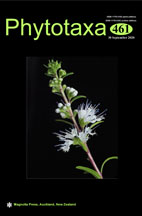Abstract
The recognition of many species of Sargassum has been difficult because morphological characters show significant phenotypic variation depending on habitat, season, or even differences at the population level. To resolve some of these systematic issues along the Mexican Atlantic coast, molecular analyses of Sargassum species were carried out using DNA sequences of the COI-5P, ITS-2 and rbcL_S genetic markers. Of the 16 species recorded for the area, five species (S. acinarium, S. mathiesonii, S. pteropleuron, S. pusillum and S. ramifolium) were not found during the collections and their status remains undefined. Phylogenetic analyses of the three molecular markers showed that 10 species with their varieties (S. bermudense, S. buxifolium, S. cymosum, S. filipendula, S. fluitans, S. furcatum, S. hystrix, S. natans, S. polyceratium, and S. vulgare) were grouped into a polytomy, with low genetic diversity. If we consider these markers as suitable for proxy for species delimitation, these species should be synonymized under S. cymosum, the older name. Taxonomic independence was confirmed only for S. platycarpum and our data revealed a new morphologically and molecularly independent species within the genus, described here as Sargassum xochitlae.

